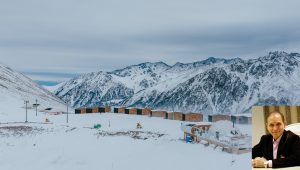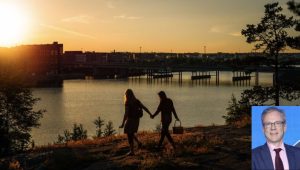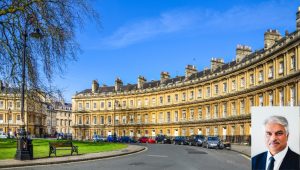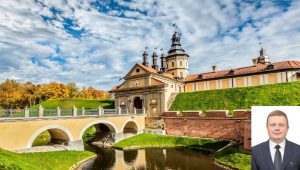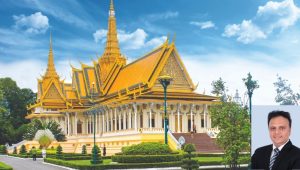Spreading Happiness Worldwide
Known as one of the most beautiful countries on earth naturally – due to its fjords, mountains, a vibrant culture and the midnight sun – Norway (of course its people) has also consistently shown light to the rest of the world as one of the happiest and safest places on Earth. It believes in “all men’s rights”, and is home to one of the most modern societies and urban & rural living places. Its hundred and thousands of lakes, the world’s longest tunnel, its more than 240,000 islands and a coastline of more than 64,000 miles are just incidental. The entire world needs to learn a lot from this majestic country.
By His Excellency Jens Eikaas, Ambassador to the UAE, Kingdom of Norway.
Norway has a great vision, and we want to preserve Norway as a good country to live in for future generations, and to carry with us the strong aspects of Norwegian society. We have high employment, and we benefit from abundant natural resources and a strong fiscal position. Our education system contributes to a well-educated workforce. Income and welfare are more evenly distributed than in most countries. In the years ahead, Norway will nevertheless face challenges. Our ability to tackle these challenges requires that we are successful in some main areas:
An inclusive labour market with high participation rates:
A cornerstone of Norwegian society is its high employment rate. For the individual, having a job means a stable income, personal development, and an arena for social inclusiveness. At the same time, a sustainable welfare state is dependent on maintaining a balance between the number of people contributing to the system and the number receiving benefits. In the coming years, an ageing population means that a smaller share of the population will carry the burden of supporting the welfare state unless the retirement age increases. If many people are kept outside the workforce because of a lack of relevant skills, this burden will increase further. Higher immigration can amplify these challenges unless immigrants are well integrated in the labour market. Education and skill enhancement is the key to successfully confronting these challenges. We need to ensure that more people have access to strong vocational training programs and to higher education. At the same time, increasing life expectancy means we have to work longer. We need to ensure that we have a tax and welfare benefit system that makes it more beneficial to work than is the case today. We have to avoid a situation in which health problems, language difficulties, or a lack of a relevant and updated skillset prevent people from participating in the labor market. This will contribute to a society that creates opportunities for all.
Rising living standards must benefit everyone in society:
The vast majority of the population has benefitted from rising incomes over the past decades. In addition, the income of the next generation is less dependent on that of their parents than what is the case in many other countries. Norway has a good system of social welfare benefits and a well-functioning public sector. Technological breakthroughs will be necessary to confront climate change. New technological solutions are also a precondition for better and more sustainable social services in the future. Welfare technology may make public healthcare more efficient and better placed to manage the challenges associated with an aging population. Improving living standards will require raising productivity growth in the private sector. Over the last decade, productivity has grown more slowly than in the past. This trend is amplified by the fact that the oil and gas sector will contribute less to economic growth than in the past. Greater emphasis on protecting the environment creates a new operating environment for the private sector both in Norway and abroad. Rising protectionism and policies aimed at reversing the tide of globalization will hurt us. Managing these transitions requires that we clear the way for the creation of jobs in the private non-oil sector. Income must be created before it can be shared.
Boosting Economy Worldwide
The single-most important step by the Government of Norway to boost its economy worldwide was taken when The Government Pension Fund Global was set up in 1990 to underpin long-term considerations when phasing petroleum revenues into the Norwegian economy. An investment arm of the Central Bank of Norway – NBIM (Norges Bank Investment Management) – manages the fund on behalf of the Ministry of Finance, which owns the fund on behalf of the Norwegian people. The ministry determines the fund’s investment strategy, following advice from, among others, NBIM and discussions in Parliament. The management mandate defines the investment universe and the fund’s strategic reference index. The Ministry of Finance has on a regular basis transferred capital to the fund from the Norwegian state’s petroleum revenues. The fund’s capital is invested abroad, to avoid overheating the Norwegian economy and to shield it from the effects of oil price fluctuations. The fund invests in international equity and fixed-income markets and real estate. The aim is to have a diversified investment mix that will give the highest possible risk-adjusted return within the set guidelines. The fund was designed to be invested for the long term, but in a way that made it possible to draw on when required. Despite its name, the fund has no formal pension liabilities. No political decision has been made as to when the fund may be used to cover future pension costs, and the probability of large withdrawals from the fund is limited. This makes the fund truly long-term. The Fund is an integrated part of the government’s annual budget. Its capital inflow consists of all government petroleum revenue, net financial transactions related to petroleum activities, and net of what is spent to balance the State’s non-oil budget deficit. This means the fund is fully integrated with the state budget and that net allocations to the fund reflect the total budget surplus, including petroleum revenue. Fiscal policy is based on the guideline that over time the structural, non-oil budget deficit shall correspond to the expected real return on the fund, estimated at 3 percent.
Amity with the UAE
As Norway’s Ambassador to the UAE, I am committed to seek opportunities to expand trade and investment between our two countries, and to strengthen the economic, political and cultural ties between us. This means, among other things, taking part in bilateral meetings at an official level, working with Norwegian businesses to give advice, updates on the situation, encouraging them to look into areas of interest that they may not yet have investigated, and to look at regional possibilities. With limited amount of funding available for business promotion activities in support of Norwegian businesses seeking to expand their activities abroad, we try to put these funds to good use, by helping to finance business seminars and receptions with potential customers and officials and so on, focusing on Norwegian competences and technologies.
Strengthening Ties with India
India is an important partner to Norway. Increased trade, investments and economic cooperation with mutual benefits are the topmost priorities for our two countries. Norway was among the very first countries to recognize India’s independence, actually on Independence Day itself in 1947. We established our Embassy in New Delhi in 1952, the same year as Norway’s very first international development cooperation project, a fisheries project in Kerala. From 2010 to 2016, the number of Norwegian companies established in India increased from 60 to more than 100. Indian companies are getting large contracts in Norway. Norwegian investments in India are estimated to close to USD 14 billion. Norwegian businesses have directly generated at least 15,000 jobs in India. The overall Indo-Norwegian cooperation covers wide areas such as energy and climate change, energy, environment and biodiversity, clean technologies, geohazards, health, gender, local governance, culture, and business. Our partnership is founded on mutual interests and respect.
Once in a Lifetime Destination
Many visitors, and no doubt the majority, associate Norway with nature, fjords, mountains, a cold climate and the northern lights. However, more and more visitors also say that they could experience interesting culture and history on a holiday in Norway, and that Norway is a place to experience exciting city life. The counterpoint to Norway’s natural beauty is found in Norway’s vibrant cultural life. Norwegian cities are cosmopolitan and brimful of architecture that showcases the famous Scandinavian flair for design through the ages. At the same time, a busy calendar of festivals, many of international renown, are worth planning your trip around. Altogether, Norway comes out well in overall rankings of tourist destinations. In the 2015 World Economic Forum’s Travel & Tourism Competitiveness Index, Norway is ranked No. 20. On a global scale, that is a rather impressive ranking. It is, for example, ahead of all countries in this region as tourist destinations, with the United Arab Emirates trailing closest, at No. 24.







